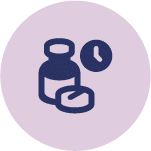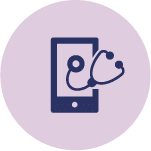How we can help your Rosacea
In today’s day and age of Google, social media and magazines- it is easy to feel overwhelmed with all the information that is out there on Rosacea. It is even harder to try and filter this information, so you be confident that what you are reading is accurate, unbiased and reliable.
As dermatology specialists, we have written this simple guide to make it easier for you to choose the best Rosacea treatments and advice. Our guide is trustworthy, reliable and evidence-based (i.e. the treatments and advice have been proven to work in previous studies). It has been written by registered health-care professionals- hence you can trust that we will always put patient safety and choice above commercial interests.
We hope this guide will help you understand what Rosacea is, how to identify it and understand some of the treatment options available. There is also a great FAQ section at the end to answer some of the most puzzling Rosacea questions that people ask us. There is also a section on our Top Tips for Rosacea.
Please read the guide at your leisure and if you are still unsure of what treatment you may require, fill in a general questionnaire and attach some photos and we will suggest a treatment. Or you can book in for a telephone or video consultation with one of our friendly dermatology experts.
Rosacea is a common, long -term inflammatory skin condition that affects the face and causes symptoms of redness, flushing and spots. It is seen in both men and women and usually affects those over the age of 30, with fair-skin and blue eyes. It can sometimes cause intense swelling, burning or stinging of the skin. It tends to come and go and flare up when it is aggravated by things such as stress, caffeine, spicy foods, alcohol, sunlight and exercise.
Rosacea can also affect the eyes causing things like dryness and minor eye infections (e.g. conjunctivitis). Other rarer complications can include thickening of the tissues of the nose (Rhinophyma).
Rosacea affects about 5% of adults all over the world but the exact cause remains largely unknown. It is likely that the cause of rosacea is due to a combination of factors including:
- Genetics– people with rosacea may have inherited genes form their family that may make them more likely to develop the condition or have an overactive immune response to the triggers of rosacea.
- Bacteria– there may be the overgrowth of some normal bacteria on the skin that leads to an increase in inflammation and redness of the skin.
- Mites– a common microscopic mite that is commonly found on human skin called Demodex folliculorum may cause inflammation and other symptoms of rosacea.
- Triggers– the most common trigger appears to be exposure to UV light (direct sunshine)- other triggers include psychological stress, air pollution, caffeine, spicy foods, alcohol, exercise and medications (including steroids).
In a nutshell:
- Persistent Redness that affects the central facial area (forehead, nose, cheeks and chin).
- Flushing- occasional periods where you get an increased redness, warmth, burning, stinging, swelling and/or pain on you skin.
- Tiny visible blood vessels on the skin surface (Telangiectasia)
- Inflamed, pus filled spots (papules and pustules)
- THERE ARE NO BLACKHEADS (closed comedones)- this helps us differentiate it from acne!
Eye symptoms will also occur in around 50% of patients e.g. dry, irritated, red or infected eyes. In a very small number of patients there will be facial skin tissue thickening, including a bulbous-like appearance of the nose (Rhinophyma)- if this is severe then we would recommend seeing you G.P to discuss your options, which may include referral to a plastic surgeon.
Most cases of Rosacea are straightforward and easy to self-diagnose. We make the diagnosis of Rosacea based on the type and number of symptoms that are present (as recommended by the 2017 Global Rosacea Consensus (ROSCO) panel.
Identifying the right type of Rosacea will help us select the correct treatments which are more likely to be effective for treating certain symptoms. It is important to note that a person can have one type or multiple types existing together.
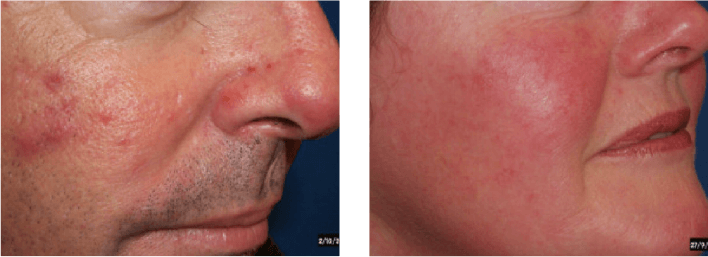
Type 1: Rosacea with mostly central facial redness, flushing, swelling and visible small blood vessels (Erythematotelangiectatic Rosacea)
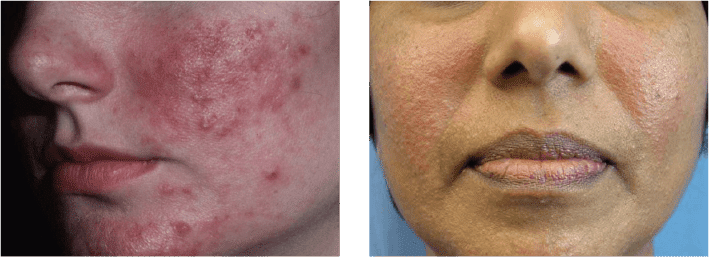
Type 2: Rosacea with persistent redness and spots (some filled with pus)- No Blackheads as in acne (Papulopustular Rosacea)- we would include Perioral Dermatitis here (a variant of rosacea common in young women where there are spots and redness around the mouth).
BOTH TYPE 1 AND TYPE 2 CAN OCCUR ALONE OR TOGETHER AND MAY REQUIRE MORE THAN ONE TREATMENT
There are rarer forms of Rosacea that we do not treat at DigiDerm and are best looked at by you G.P:
Type 3: Rosacea with facial skin thickening, e.g., Rhinophyma of the nose- most seen in older men.
Type 4: Rosacea solely around the eye area- can cause irritation, dryness, watery eyes, minor eye infections including blepharitis and conjunctivitis.
What else could it be?
If you are unsure if you have Rosacea or something similar, then either fill in a general questionnaire with some photos and we will advise you; or you can book in for a telephone or video consultation.
The most common alternative diagnoses that can be quite similar to Rosacea are:
Acne: there is normally greasiness, whiteheads and blackheads (comedones) and lack of background redness.
Seborrhoeic Dermatitis: this may occur alongside rosacea and there is usually a history of dandruff, dryness and scaly (flakey) skin in the: naso-labial fold (the crease at the side of your nose), eyebrows, ears, chin, upper chest.
Perioral Dermatitis: this is a variant of rosacea and us typically seen in young women where there are spots (papules) around the mouth and/ or eyes.
Eczema: Atopic eczema would normally include redness and scaling on the arms or legs. Contact Dermatitis would normally include small fluid filled blisters on the face after using a particular product.
Psoriasis: Signs of psoriasis would include well-defined scaly patches on the knees, elbows and scalp with nail pitting.
NOTE: Don’t worry if you are unsure of what treatments to select or what type of Rosacea you have. You can start a simple online questionnaire-based consultation, attach some photos, and we will let you know if the treatment you have selected is safe and appropriate- if not, we will recommend an alternative. If you’d prefer to talk over the phone, you can book in for a 20 minute telephone or video consultation with one of our friendly dermatology specialists and we can recommend suitable treatments and advice.
Whilst there is no known cure for Rosacea, we know that it can be very well controlled in the long. Patients are normally very responsive to the right treatment, and we can see great results. Many people will see results within days to weeks- however, we would recommend given treatments at least 3 months of consecutive use to see maximum benefits. If your Rosacea goes away but then comes back- a course of treatment can be repeated. If your rosacea keeps coming back frequently then after a standard course of treatment you may wish to consider staying on a preventative low dose course of treatment: e.g. the creams, gels or oral antibiotics 2-3 times per week instead of every day.
General advice for Rosacea
- Avoid the triggers e.g direct sunshine, stress, caffeine, spicy foods, alcohol, exercise
- Gently Cleanse every day– Very gently cleanse your skin to remove excess dirt and irritants and keep pores unblocked- use a gentle rosacea -friendly cleanser e.g. CeraVe SA Smoothing Cleanser or Cetaphil Gentle Skin Cleanser
- Use a rosacea-friendly, light, non-oily emollient that may help soothe the skin and keep the skin barrier well maintained e.g. Cetaphil Moisturising Lotion or CeraVe AM Facial Moisturising Lotion
- Avoid any emollients/ moisturisers that may burn/ sting when you apply them– avoid ingredients such as Alcohol, Camphor, Fragrance, Glycolic acid, Lactic acid, Menthol, Sodium laurel sulphate (SLS) and Urea
- Use sun protection with a high SPF– people with rosacea may find it less irritating to use a physical sunscreen as opposed to a chemical one- e.g. SunSense Sunsensitive Cream 100g SPF50+
Here are some of the treatment choices that we offer for Rosacea in line with the latest clinical guidelines for dermatology in the UK (click on the product for more information and to start a consultation).
FOR TYPE 1 ROSACEA
(MAIN SYMPTOMS ARE PERSISTENT REDNESS, TINY BLOOD VESSELS AND FLUSHING (PERIODIC FLARES OF REDNESS, WARMTH, STINGING)):
Mirvaso Gel: this is a topical Brimonidine Gel that can be used once daily on as ‘as needed’ basis for temporary relief of symptoms- it is fast-acting and can reduce redness within 30minutes of application and lasts up to around 6 hours.
Finacea 15% Gel: this is a topical gel with Azelaic Acid which is applied twice a day and helps reduce redness. It is naturally found in barley, wheat and rye and has antibacterial and anti-inflammatory properties.
Dermalex Rosacea Treatment: this is an over-the-counter product available at DigiDerm that can be used alone for very mild rosacea or combined with other prescription-only treatments. It is gentle on the skin and contains chamomile and echinacea.
FOR TYPE 2 ROSACEA
(MAIN SYMPTOMS ARE INFLAMMED SPOTS (SOME FILLED WITH PUS) ON A BACKGROUND OF PERSISTENT REDNESS):
CREAMS & GELS
Soolantra Cream: this is a daily topical cream containing Ivermectin which kills the Demodex mite thought to be responsible for Rosacea. It is well tolerated and is recommended as the first-choice treatment for Type 2 rosacea.
Rozex 0.75% Gel: this is a topical antibiotic gel containing Metronidazole that is applied twice a day and will help to reduce the overall symptoms of rosacea.
Finacea 15% Gel: this is a topical gel with Azelaic Acid which is applied twice a day and helps reduce redness. It is naturally found in barley, wheat and rye and has antibacterial and anti-inflammatory properties.
TABLETS AND CAPSULES
If topical medication fails or if symptoms are more severe then oral antibiotics can be used for a standard treatment length of 3 months. It is possible to combined both an oral antibiotic with a topical cream or gel- for example, using Soolantra Cream and Efracea Capsules together for maximum effect.
Efracea 40mg MR Capsules: this is a once daily slow-release oral antibiotic containing Doxycycline which was specifically designed to treat rosacea- it will reduce the overall symptoms.
Tetralysal 300 Capsules: this is a once daily oral antibiotic containing Lymecycline which is from the same class of antibiotics (tetracyclines) as Efracea.
Erythromycin 250mg Tablets: this is an oral antibiotic designed to be taken twice a day and is a useful alternative to the tetracyclines (Efracea and Tetralysal) if you find them ineffective or have side effects. It may also be used in pregnancy and breastfeeding and we would advise discussing the risk versus benefits with a healthcare professional.
BOTH TYPE 1 AND TYPE 2 FEATURES OR MORE SEVERE DISEASE
(REDNESS, FLUSHING, BLOOD VESSELS AND SPOTS)
If there are features of both type 1 and type 2 or more severe symptoms then we would advise:
Firstly: Try either Soolantra cream, Rozex Gel OR Finacea gel for 3 months (with or without Mirvaso on an ‘as needed’ basis for redness).
Secondly: If symptoms persist or are severe then we would advise combing a topical cream or gel with an oral antibiotic for 3 months (with or without Mirvaso on an ‘as needed’ basis for redness)
Suitable combinations would include:
- Soolantra cream + Efracea capsules
- Soolantra cream + Erythromycin tablets
- Rozex gel + Efracea capsules
- Rozex gel + Tetralysal capsules
- Finacea gel + Efracea capsules
- Finacea gel + Erythromycin tablets
IMPORTANT: If you have any severe symptoms that are causing psychological or social distress, or have tried a combination of topical and oral treatment for 3 months with no benefit- we would advise you to speak to your GP for further guidance on treatment. Your GP may be able to refer you to a consultant dermatologist for consideration of more specialist treatments such as oral isotretinoin.
Management of Eye Symptoms
Around 50% of patients with rosacea may suffer with some eye involvement e.g. dry, irritated, red eyes or minor eye infections such as blepharitis and conjunctivitis. If these symptoms are severe or very concerning for you then please consult with your G.P. If these are minor, then we would recommend:
- Eyelid hygiene– gently clean the eye lids with cotton wool and sterile water (cooled, boiled water) or some baby shampoo.
- Eye lubricants– artificial tear liquids and ointments can be purchased from a pharmacy and can be applied throughout the day to ease symptoms.
- Oral antibiotics such as Efracea 40mg MR Capsules or Erythromycin 250mg Tablets may help treat ocular rosacea.
- Avoid retinoids (e.g. adapalene, tretinoin) if you have rosacea-associated eye problems as they can worsen symptoms.
Popular Ingredients to look out for in Over-the-counter (OTC) Rosacea Products include
Azelaic Acid
in lower OTC strengths as part of other products it may help reduce redness and inflammation.
Nicotinamide/ Niacinamide
A water-soluble form of vitamin B3- may reduce inflammation and repair damaged skin in Rosacea.
Zinc
Has anti-inflammatory and astringent properties which will help reduce redness of rosacea prone skin.
Camouflage
Skin camouflage is an easy-to-apply, long-lasting, waterproof, and highly pigmented cream and powder that can be applied over scars and non-infectious skin conditions to help them blend into the normal skin colour. Changing Faces is the leading UK charity that supports people with skin conditions such as rosacea, and they offer an excellent tailored Skin Camouflage service (https://www.changingfaces.org.uk/services-support/skin-camouflage-service/) where you can book an appointment yourself or if you prefer you can speak to your G.P first and they can refer you. Brands include Dermacolor, Veil, Covermark and Keromask and they are available on NHS prescription.
Green Tea
This has antioxidant and anti-inflammatory properties which may help redness redness and burning caused by rosacea.
Camouflage
Skin camouflage is an easy-to-apply, long-lasting, waterproof, and highly pigmented cream and powder that can be applied over scars and non-infectious skin conditions to help them blend into the normal skin colour. Changing Faces is the leading UK charity that supports people with skin conditions such as rosacea, and they offer an excellent tailored Skin Camouflage service (https://www.changingfaces.org.uk/services-support/skin-camouflage-service/) where you can book an appointment yourself or if you prefer you can speak to your G.P first and they can refer you. Brands include Dermacolor, Veil, Covermark and Keromask and they are available on NHS prescription.
Laser and Light Treatments
These are particularly effective for treating rosacea where redness with visible blood vessels (telangiectasia) is a problem. Intense pulsed light (IPL) and pulsed-dye laser (PDL) can be very effective although improvement is not permanent and therefore maintenance treatment may be required. The treatments require a series of sessions every 1-2 months for 6-12months. These treatments are not available in all areas of the country for rosacea under the NHS, but you can find private dermatologist clinics who may offer this service.
Isotretinoin
This is a specialist medication normally prescribed within a hospital clinic led by a consultant dermatologist. It may help improve symptoms in severe, resistant forms of rosacea and is given at a lower dose than for acne. We do not offer this treatment at DigiDerm, but you may be able to speak to your GP to see if referral is available to specialist NHS dermatology services in your area.
Clonidine and Propranolol
These oral prescription-only medications may help with persistent redness, visible blood and vessels and flushing. We do not offer these treatments at DigiDerm, but we would advise discussing them with your family GP who may be willing to prescribe them off-license if other treatments haven’t worked.
- Use Daily Sun Protection– This is one of the most important and often overlooked features of good rosacea management. Use SPF 25/30 minimum if possible. Some moisturisers come with SPF built in e.g. Acnecide Moisturiser SPF30 and CeraVe AM Facial Moisturising Lotion
- Have a Consistent Skin Care Routine– Keep it simple and avoid using scrubs, toners and anything that may irritate. Cleanse your face twice a day with a rosacea-friendly gentle cleanser such as non-foaming CeraVe Hydrating Cleanser or Cetaphil Gentle Skin Cleanser. Moisturise every day as this has been proven to improve the results you see form using prescription-only treatments- use light non-greasy moisturizers such as CeraVe AM Facial Moisturising Lotion.
- Use Mineral-Based Make-up– If you have to use make-up- this may be less irritant e.g. Dermablend or Colorescience. To reduce redness, a green-tinted primer cab be applied before using an oil-free foundation.
- Read the Ingredients – Before you buy any skin care or cosmetic products check they are free of irritants such as: Alcohol, Camphor, Fragrances, Glycolic acid, Lactic acid, Menthol, Sodium laurel Sulphate (SLS) and Urea
- Learn what your Triggers are– Avoid them like the plague: they are often specific to you.

A Guide to Rosacea
In today’s day and age of Google, social media and magazines- it is easy to feel overwhelmed with all the information that is out there on Rosacea. It is even harder to try and filter this information, so you be confident that what you are reading is accurate, unbiased and reliable.
As dermatology specialists, we have written this simple guide to make it easier for you to choose the best Rosacea treatments and advice. Our guide is trustworthy, reliable and evidence-based (i.e. the treatments and advice have been proven to work in previous studies). It has been written by registered health-care professionals- hence you can trust that we will always put patient safety and choice above commercial interests.
We hope this guide will help you understand what Rosacea is, how to identify it and understand some of the treatment options available. There is also a great FAQ section at the end to answer some of the most puzzling Rosacea questions that people ask us. There is also a section on our Top Tips for Rosacea.
Please read the guide at your leisure and if you are still unsure of what treatment you may require, fill in a general questionnaire and attach some photos and we will suggest a treatment. Or you can book in for a telephone or video consultation with one of our friendly dermatology experts.

What you need to know about Rosacea
Rosacea is a common, long -term inflammatory skin condition that affects the face and causes symptoms of redness, flushing and spots. It is seen in both men and women and usually affects those over the age of 30, with fair-skin and blue eyes. It can sometimes cause intense swelling, burning or stinging of the skin. It tends to come and go and flare up when it is aggravated by things such as stress, caffeine, spicy foods, alcohol, sunlight and exercise. Rosacea can also affect the eyes causing things like dryness and minor eye infections (e.g. conjunctivitis). Other rarer complications can include thickening of the tissues of the nose (Rhinophyma).
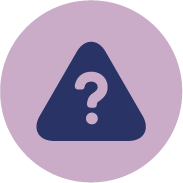
What Causes Rosacea?
Rosacea affects about 5% of adults all over the world but the exact cause remains largely unknown. It is likely that the cause of rosacea is due to a combination of factors including:
- Genetics– people with rosacea may have inherited genes form their family that may make them more likely to develop the condition or have an overactive immune response to the triggers of rosacea.
- Bacteria– there may be the overgrowth of some normal bacteria on the skin that leads to an increase in inflammation and redness of the skin.
- Mites– a common microscopic mite that is commonly found on human skin called Demodex folliculorum may cause inflammation and other symptoms of rosacea.
- Triggers– the most common trigger appears to be exposure to UV light (direct sunshine)- other triggers include psychological stress, air pollution, caffeine, spicy foods, alcohol, exercise and medications (including steroids).
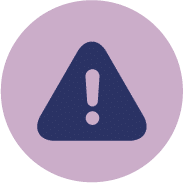
What are the Symptoms of Rosacea?
In a nutshell:
- Persistent Redness that affects the central facial area (forehead, nose, cheeks and chin).
- Flushing- occasional periods where you get an increased redness, warmth, burning, stinging, swelling and/or pain on you skin.
- Tiny visible blood vessels on the skin surface (Telangiectasia)
- Inflamed, pus filled spots (papules and pustules)
- THERE ARE NO BLACKHEADS (closed comedones)- this helps us differentiate it from acne!
Eye symptoms will also occur in around 50% of patients e.g. dry, irritated, red or infected eyes. In a very small number of patients there will be facial skin tissue thickening, including a bulbous-like appearance of the nose (Rhinophyma)- if this is severe then we would recommend seeing you G.P to discuss your options, which may include referral to a plastic surgeon.

How is Rosacea Diagnosed?
Most cases of Rosacea are straightforward and easy to self-diagnose. We make the diagnosis of Rosacea based on the type and number of symptoms that are present (as recommended by the 2017 Global Rosacea Consensus (ROSCO) panel.
Identifying the right type of Rosacea will help us select the correct treatments which are more likely to be effective for treating certain symptoms. It is important to note that a person can have one type or multiple types existing together.

Type 1: Rosacea with mostly central facial redness, flushing, swelling and visible small blood vessels (Erythematotelangiectatic Rosacea)

Type 2: Rosacea with persistent redness and spots (some filled with pus)- No Blackheads as in acne (Papulopustular Rosacea)- we would include Perioral Dermatitis here (a variant of rosacea common in young women where there are spots and redness around the mouth).
BOTH TYPE 1 AND TYPE 2 CAN OCCUR ALONE OR TOGETHER AND MAY REQUIRE MORE THAN ONE TREATMENT
There are rarer forms of Rosacea that we do not treat at DigiDerm and are best looked at by you G.P:
Type 3: Rosacea with facial skin thickening, e.g., Rhinophyma of the nose- most seen in older men.
Type 4: Rosacea solely around the eye area- can cause irritation, dryness, watery eyes, minor eye infections including blepharitis and conjunctivitis.
What else could it be?
If you are unsure if you have Rosacea or something similar, then either fill in a general questionnaire with some photos and we will advise you; or you can book in for a telephone or video consultation.
The most common alternative diagnoses that can be quite similar to Rosacea are:
Acne: there is normally greasiness, whiteheads and blackheads (comedones) and lack of background redness.
Seborrhoeic Dermatitis: this may occur alongside rosacea and there is usually a history of dandruff, dryness and scaly (flakey) skin in the: naso-labial fold (the crease at the side of your nose), eyebrows, ears, chin, upper chest.
Perioral Dermatitis: this is a variant of rosacea and us typically seen in young women where there are spots (papules) around the mouth and/ or eyes.
Eczema: Atopic eczema would normally include redness and scaling on the arms or legs. Contact Dermatitis would normally include small fluid filled blisters on the face after using a particular product.
Psoriasis: Signs of psoriasis would include well-defined scaly patches on the knees, elbows and scalp with nail pitting.

What is the Best Treatment for Rosacea?
NOTE: Don’t worry if you are unsure of what treatments to select or what type of Rosacea you have. You can start a simple online questionnaire-based consultation, attach some photos, and we will let you know if the treatment you have selected is safe and appropriate- if not, we will recommend an alternative. If you’d prefer to talk over the phone, you can book in for a 20 minute telephone or video consultation with one of our friendly dermatology specialists and we can recommend suitable treatments and advice.
Whilst there is no known cure for Rosacea, we know that it can be very well controlled in the long. Patients are normally very responsive to the right treatment, and we can see great results. Many people will see results within days to weeks- however, we would recommend given treatments at least 3 months of consecutive use to see maximum benefits. If your Rosacea goes away but then comes back- a course of treatment can be repeated. If your rosacea keeps coming back frequently then after a standard course of treatment you may wish to consider staying on a preventative low dose course of treatment: e.g. the creams, gels or oral antibiotics 2-3 times per week instead of every day.
General advice for Rosacea
- Avoid the triggers e.g direct sunshine, stress, caffeine, spicy foods, alcohol, exercise
- Gently Cleanse every day- Very gently cleanse your skin to remove excess dirt and irritants and keep pores unblocked- use a gentle rosacea -friendly cleanser e.g. CeraVe SA Smoothing Cleanser or Cetaphil Gentle Skin Cleanser
- Use a rosacea-friendly, light, non-oily emollient that may help soothe the skin and keep the skin barrier well maintained e.g. Cetaphil Moisturising Lotion or CeraVe AM Facial Moisturising Lotion
- Avoid any emollients/ moisturisers that may burn/ sting when you apply them- avoid ingredients such as Alcohol, Camphor, Fragrance, Glycolic acid, Lactic acid, Menthol, Sodium laurel sulphate (SLS) and Urea
- Use sun protection with a high SPF- people with rosacea may find it less irritating to use a physical sunscreen as opposed to a chemical one- e.g. SunSense Sunsensitive Cream 100g SPF50+
Here are some of the treatment choices that we offer for Rosacea in line with the latest clinical guidelines for dermatology in the UK (click on the product for more information and to start a consultation).
FOR TYPE 1 ROSACEA
(MAIN SYMPTOMS ARE PERSISTENT REDNESS, TINY BLOOD VESSELS AND FLUSHING (PERIODIC FLARES OF REDNESS, WARMTH, STINGING)):
Mirvaso Gel: this is a topical Brimonidine Gel that can be used once daily on as ‘as needed’ basis for temporary relief of symptoms- it is fast-acting and can reduce redness within 30minutes of application and lasts up to around 6 hours.
Finacea 15% Gel: this is a topical gel with Azelaic Acid which is applied twice a day and helps reduce redness. It is naturally found in barley, wheat and rye and has antibacterial and anti-inflammatory properties.
Dermalex Rosacea Treatment: this is an over-the-counter product available at DigiDerm that can be used alone for very mild rosacea or combined with other prescription-only treatments. It is gentle on the skin and contains chamomile and echinacea.
FOR TYPE 2 ROSACEA
(MAIN SYMPTOMS ARE INFLAMMED SPOTS (SOME FILLED WITH PUS) ON A BACKGROUND OF PERSISTENT REDNESS):
CREAMS & GELS
Soolantra Cream: this is a daily topical cream containing Ivermectin which kills the Demodex mite thought to be responsible for Rosacea. It is well tolerated and is recommended as the first-choice treatment for Type 2 rosacea.
Rozex 0.75% Gel: this is a topical antibiotic gel containing Metronidazole that is applied twice a day and will help to reduce the overall symptoms of rosacea.
Finacea 15% Gel: this is a topical gel with Azelaic Acid which is applied twice a day and helps reduce redness. It is naturally found in barley, wheat and rye and has antibacterial and anti-inflammatory properties.
TABLETS AND CAPSULES
If topical medication fails or if symptoms are more severe then oral antibiotics can be used for a standard treatment length of 3 months. It is possible to combined both an oral antibiotic with a topical cream or gel- for example, using Soolantra Cream and Efracea Capsules together for maximum effect.
Efracea 40mg MR Capsules: this is a once daily slow-release oral antibiotic containing Doxycycline which was specifically designed to treat rosacea- it will reduce the overall symptoms.
Tetralysal 300 Capsules: this is a once daily oral antibiotic containing Lymecycline which is from the same class of antibiotics (tetracyclines) as Efracea.
Erythromycin 250mg Tablets: this is an oral antibiotic designed to be taken twice a day and is a useful alternative to the tetracyclines (Efracea and Tetralysal) if you find them ineffective or have side effects. It may also be used in pregnancy and breastfeeding and we would advise discussing the risk versus benefits with a healthcare professional.
BOTH TYPE 1 AND TYPE 2 FEATURES OR MORE SEVERE DISEASE
(REDNESS, FLUSHING, BLOOD VESSELS AND SPOTS)
If there are features of both type 1 and type 2 or more severe symptoms then we would advise:
Firstly: Try either Soolantra cream, Rozex Gel OR Finacea gel for 3 months (with or without Mirvaso on an ‘as needed’ basis for redness).
Secondly: If symptoms persist or are severe then we would advise combing a topical cream or gel with an oral antibiotic for 3 months (with or without Mirvaso on an ‘as needed’ basis for redness)
Suitable combinations would include:
- Soolantra cream + Efracea capsules
- Soolantra cream + Erythromycin tablets
- Rozex gel + Efracea capsules
- Rozex gel + Tetralysal capsules
- Finacea gel + Efracea capsules
- Finacea gel + Erythromycin tablets
IMPORTANT: If you have any severe symptoms that are causing psychological or social distress, or have tried a combination of topical and oral treatment for 3 months with no benefit- we would advise you to speak to your GP for further guidance on treatment. Your GP may be able to refer you to a consultant dermatologist for consideration of more specialist treatments such as oral isotretinoin.
Management of Eye Symptoms
Around 50% of patients with rosacea may suffer with some eye involvement e.g. dry, irritated, red eyes or minor eye infections such as blepharitis and conjunctivitis. If these symptoms are severe or very concerning for you then please consult with your G.P. If these are minor, then we would recommend:
- Eyelid hygiene- gently clean the eye lids with cotton wool and sterile water (cooled, boiled water) or some baby shampoo.
- Eye lubricants- artificial tear liquids and ointments can be purchased from a pharmacy and can be applied throughout the day to ease symptoms.
- Oral antibiotics such as Efracea 40mg MR Capsules or Erythromycin 250mg Tablets may help treat ocular rosacea.
- Avoid retinoids (e.g. adapalene, tretinoin) if you have rosacea-associated eye problems as they can worsen symptoms.

What Alternative Treatments are there for Rosacea?
Popular Ingredients to look out for in Over-the-counter (OTC) Rosacea Products include
Azelaic Acid
in lower OTC strengths as part of other products it may help reduce redness and inflammation.
Nicotinamide/ Niacinamide
A water-soluble form of vitamin B3- may reduce inflammation and repair damaged skin in Rosacea.
Zinc
Has anti-inflammatory and astringent properties which will help reduce redness of rosacea prone skin.
Green Tea
This has antioxidant and anti-inflammatory properties which may help redness redness and burning caused by rosacea.
Camouflage
Skin camouflage is an easy-to-apply, long-lasting, waterproof, and highly pigmented cream and powder that can be applied over scars and non-infectious skin conditions to help them blend into the normal skin colour. Changing Faces is the leading UK charity that supports people with skin conditions such as rosacea, and they offer an excellent tailored Skin Camouflage service (https://www.changingfaces.org.uk/services-support/skin-camouflage-service/) where you can book an appointment yourself or if you prefer you can speak to your G.P first and they can refer you. Brands include Dermacolor, Veil, Covermark and Keromask and they are available on NHS prescription.
Laser and Light Treatments
These are particularly effective for treating rosacea where redness with visible blood vessels (telangiectasia) is a problem. Intense pulsed light (IPL) and pulsed-dye laser (PDL) can be very effective although improvement is not permanent and therefore maintenance treatment may be required. The treatments require a series of sessions every 1-2 months for 6-12months. These treatments are not available in all areas of the country for rosacea under the NHS, but you can find private dermatologist clinics who may offer this service.
Isotretinoin
This is a specialist medication normally prescribed within a hospital clinic led by a consultant dermatologist. It may help improve symptoms in severe, resistant forms of rosacea and is given at a lower dose than for acne. We do not offer this treatment at DigiDerm, but you may be able to speak to your GP to see if referral is available to specialist NHS dermatology services in your area.
Clonidine and Propranolol
These oral prescription-only medications may help with persistent redness, visible blood and vessels and flushing. We do not offer these treatments at DigiDerm, but we would advise discussing them with your family GP who may be willing to prescribe them off-license if other treatments haven’t worked.

Top Tips for Rosacea
- Use Daily Sun Protection- This is one of the most important and often overlooked features of good rosacea management. Use SPF 25/30 minimum if possible. Some moisturisers come with SPF built in e.g. Acnecide Moisturiser SPF30 and CeraVe AM Facial Moisturising Lotion
- Have a Consistent Skin Care Routine- Keep it simple and avoid using scrubs, toners and anything that may irritate. Cleanse your face twice a day with a rosacea-friendly gentle cleanser such as non-foaming CeraVe Hydrating Cleanser or Cetaphil Gentle Skin Cleanser. Moisturise every day as this has been proven to improve the results you see form using prescription-only treatments- use light non-greasy moisturizers such as CeraVe AM Facial Moisturising Lotion.
- Use Mineral-Based Make-up- If you have to use make-up- this may be less irritant e.g. Dermablend or Colorescience. To reduce redness, a green-tinted primer cab be applied before using an oil-free foundation.
- Read the Ingredients – Before you buy any skin care or cosmetic products check they are free of irritants such as: Alcohol, Camphor, Fragrances, Glycolic acid, Lactic acid, Menthol, Sodium laurel Sulphate (SLS) and Urea
- Learn what your Triggers are- Avoid them like the plague: they are often specific to you.

Frequently Asked Questions

Frequently Asked Questions
There is not a great deal of evidenced- based over the counter treatments for rosacea available in the UK. There are many non-prescription skincare products that are marketed for rosacea, and these may be suitable for very mild rosacea symptoms. Those that contain Azelaic acid in lower strengths are probably the most effective. It is easy to spend lots of money on the various brands of skincare products without getting any results- be careful not to waste your money. At DigiDerm we believe that anything more than very mild rosacea is best treated by a qualified dermatology healthcare professional as there is often a place for prescription-only medications in the treatment pathway.
Here at DigiDerm we are big fans of keeping it simple. We find that this means people are more likely to get into the habit of a consistent routine. If you have a consistent, simple daily routine, you are more likely to see quicker and better results. Rosacea doesn’t get cured overnight. It can take anywhere from 2-3 months to see maximum improvement, although some people may see quite significant improvement in a matter of days to weeks There is no ‘one-size fits all’ routine as people with rosacea may have different skin types (e.g. oily, sensitive, dry).
Morning
- Cleansing with an aqueous based cleanser (see treatments section above)
- Apply Prescription or other Rosacea cream/gel (If appropriate)
- Moisturising with a water-based product (especially if you have dry skin or skin irritated from you prescription strength rosacea treatment)
- Apply SPF / Sunscreen
- Apply make-up last (although make-up is best avoided whilst undergoing rosacea treatment!)
Afternoon
- Remove Makeup using an oil-free makeup remover
- Cleansing with an aqueous based cleanser (see treatments section above)
- Apply Prescription or other Rosacea cream/gel (If appropriate)
- Moisturising with a water-based product (especially if you have dry skin or skin irritated from you prescription strength rosacea treatment)
Rosacea and Acne are different skin conditions and have different causes and treatments. They can appear to look the same to the untrained eye, but there are a few key differences:
ROSACEA
ACNE
Mainly affects those over 30 years old (more common in those with fair skin)
Mainly affect Teenagers and those in 20’s
No blackheads, Pimple-like breakouts mainly on face and eyes (redness can extend to scalp, neck, chest, upper back)
Blackheads, whiteheads, pimples, cysts and nodules on face, jawline, back and chest
Widespread Redness in the centre of your face -cheeks, forehead, nose and chin- this can come and go or be permanent
Redness around your spots only
Widespread Redness in the centre of your face -cheeks, forehead, nose and chin- this can come and go or be permanent
Oily skin
Large pores in the skin and visible blood vessels
Bumpy skin textures from blemishes or scar
Eye problems- bloodshot eyes, swollen eyelids and discomfort
Other skin conditions that commonly disguise themselves as rosacea are perioral dermatitis, folliculitis and keratosis pilaris. If you are unsure whether you have rosacea, please book in for a friendly telephone consultation with one of our dermatology pharmacists who can discuss how we can help.
No, but it can be very well managed. It is a chronic (long-term) condition which goes through periods of getting better and worse. Avoiding your triggers, wearing SPF and using the right treatments are crucial to long term successful management.
Rosacea can occur in pregnancy and sometimes worsens due to stress. As with all medicines and treatments in pregnancy, there will always be a small risk attached of potential harm to the unborn child and mother. This is because most Rosacea medications and products have not been tested in pregnant women (for ethical reasons!) and therefore they do not have a robust safety profile to grant them a product license. When in doubt it is best to have a chat to a registered healthcare professional who will discuss the risk versus benefits of using medicines and treatments in pregnancy. You can book a friendly telephone consultation with one of our dermatology pharmacists to discuss treatment options for Rosacea in pregnancy if you’d prefer.
If you are planning a pregnancy or pregnant then you must avoid using topical and oral retinoid products and oral tetracycline antibiotics as these carry a high risk of harm. Treatments that are generally accepted to be safe in pregnancy include Azelaic Acid gel (Finacea), Metronidazole gel (Rozex) and Erythromycin oral antibiotics tablets. We would also advise avoiding any skincare products containing the aspirin derivative ‘salicylic acid’ as this could pose the risk of harm to an unborn baby.
Guidance for pregnancy and breastfeeding can vary from product to product so please carefully read the product information before use and always inform us if you are currently pregnant/ planning pregnancy or breastfeeding whilst completing a consultation.
There are common triggers for rosacea but there are also triggers that may be specific to you. Common food triggers include Alcohol, Spicy food, Cinnamaldehyde-containing foods (e.g. tomatoes, citrus fruits, chocolate), hot drinks, histamine-rich foods (e.g. aged cheese, wine, processed meats).
Prescription-only medicated creams and gels will unlikely cause you rosacea to get any worse, although it is possible to experience sensitivity or side effects from all medications. When buying over the counter creams make sure they don’t include any common irritants which may worsen you rosacea- avoid ingredients such as Alcohol, Witch Hazel, Peppermint, Propylene Glycol, Parabens, Camphor, Fragrance, Glycolic acid, Lactic acid, Menthol, Sodium laurel sulphate (SLS) and Urea. Use retinoids creams with caution as they can sometimes cause rosacea to flare. A useful tip is to trial a new skincare product on a small patch of skin first, for example, on the hairless part of your forearm- to make sure it does not cause you any irritation.
Unfortunately, scientists haven’t discovered a cure for rosacea yet. However, it can be well managed using treatments. Also, what is meant by natural? If you interpret natural as something that contains an active ingredient that is found in a plant or animal, then you might want to consider trying Azelaic Acid gel (Finacea) which is a prescription-only medication. Azelaic acid is a naturally occurring acid that is found in grains such as wheat, barley and rye. Other over the counter natural ingredients which may benefit very mild rosacea include aloe vera, chamomile, green tea and niacinamide- but be careful as certain people may still be sensitive to these ingredients. There is some evidence that omega-3 fish oil (as oral supplements or in fish )may have some benefit in treating rosacea, especially if it affects the eyes.
Generally, for most rosacea medications, we recommend at least 2-3 months of consistent, daily treatment to see maximum effects. Although some patients will see benefits within hours to days to weeks depending on the individual medication. For example, topical Brimonidine gel (Mirvaso) will usually reduce facial redness within minute to hours of application.
The good news for you is that DigiDerm provides an online platform for you to access treatments wherever and wherever you are. Either fill in an online questionnaire and attach some photos or book in for a telephone or video consultation with a dermatology specialist. Your medications can arrive in the post the next day. If you have very severe rosacea, rosacea that is no responding to prescription-only medication treatments, or severe psychological distress- we would recommend booking an appointment with your G.P in the first instance.
The most common classes of antibiotics used for treating Rosacea in Europe and the US are Tetracyclines, Macrolides and Metronidazole.
The benefit of Tetracyclines is that they have an additional anti-inflammatory effect which can help reduce redness and swelling- Tetracyclines would include doxycycline 40mg mr capsules (Efracea) and lymecycline. Doxycycline also comes in a 100mg capsules strength however we know that the lower 40mg MR (slow release) formulation is just as effective in reducing inflammatory lesions and has less risk of bacterial resistance developing in the long term.
Metronidazole topical treatments are effective in treating rosacea and can safely be used with suitable oral antibiotics- for example the combination of topical metronidazole gel (Rozex) and Doxycycline 40mg MR capsules (Efracea) can produce excellent results in some patients.
Macrolides include antibiotics such as Erythromycin 250mg tablets are generally considered second line for treatment in rosacea as they me be slightly less efficacious due to the lack of anti-inflammatory properties as found in tetracyclines. However, they remain a good option for patients who want to try an alternative, cannot tolerate side effects from other medications such as tetracyclines or those who are pregnant or breastfeeding.
If you require further guidance, help and support with managing any aspect of your Rosacea condition, including your mental health, then there are various organisations that may be able to provide additional support. One of them is the National Rosacea Society. Please visit our Mental Health and Skin page for further information.
At DigiDerm, we understand that everyone has their struggles, and your skin can affect your confidence, mood and self-esteem. Whilst we do not provide direct psychological therapy or prescribe mental health medications, we will do our best to listen, offer advice and point you in the right direction if needed. Your GP can also be a source of help and guidance if needed. If you feel you require more urgent care, then either speak to your GP or contact urgent out-of-ours services- see our Urgent Care Services page for more information.

